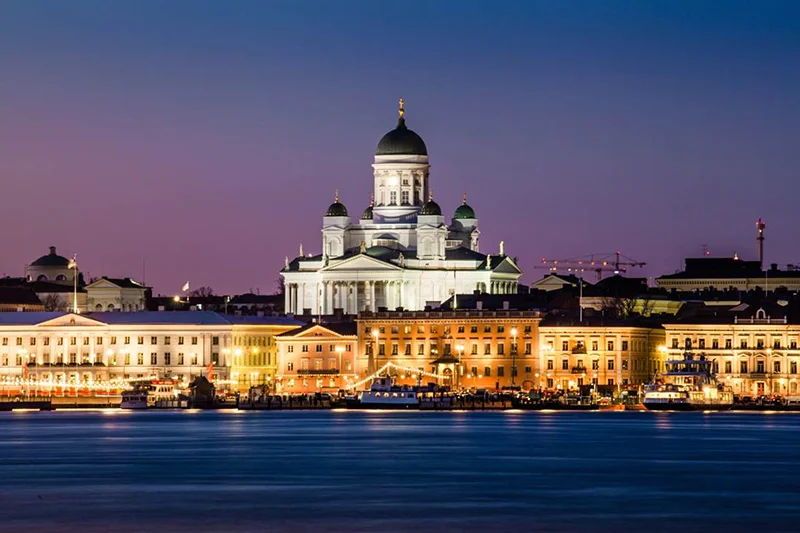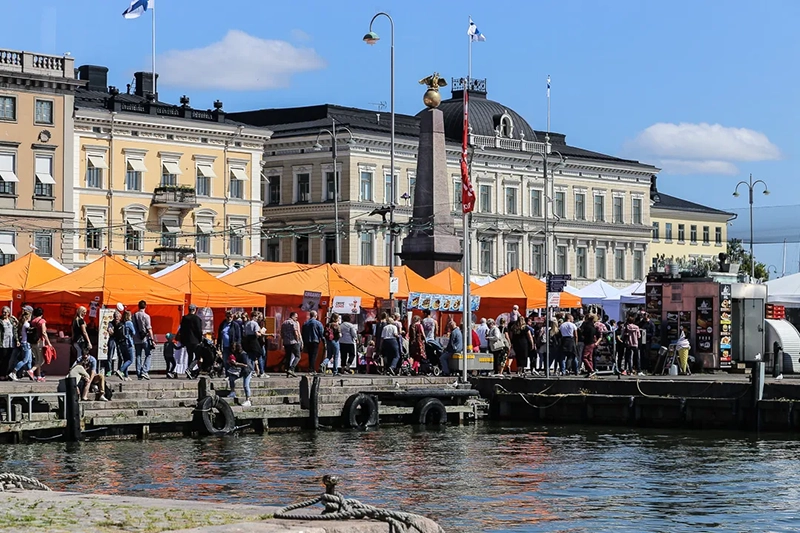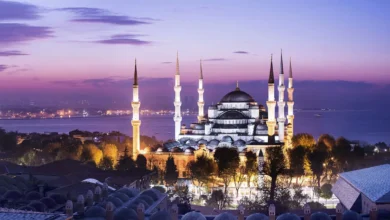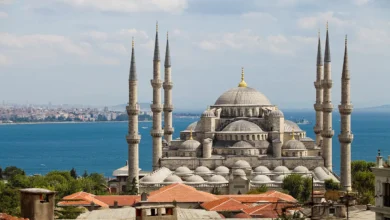
Helsinki, Finland’s dynamic capital, is a blend of historical richness and modern design. The city is renowned for its diverse architectural styles, from the striking National Romanticism of the Central Railway Station to the contemporary flair of the Kiasma Museum of Contemporary Art. The iconic Rock Church, carved directly into rock, stands as another testament to Helsinki’s unique architectural harmony with nature.
Culturally, Helsinki thrives with numerous museums and galleries. The Ateneum Art Museum showcases Finland’s oldest art collection, while the Amos Rex museum features an innovative space for contemporary exhibitions. Nature lovers can explore serene spots like the Kaisaniemi Botanic Gardens, offering a peaceful retreat amidst the urban environment.
Whether you’re drawn to art, architecture, or nature, Helsinki offers an array of attractions that seamlessly blend tradition with modernity, providing a memorable experience for every visitor.
Suomenlinna Fortress

Suomenlinna Fortress, a UNESCO World Heritage Site, is one of Helsinki’s most iconic landmarks. Built in the 18th century, it spans several islands and has been a vital military stronghold throughout history. Originally constructed by the Swedish, it played a pivotal role in defending Finland through significant historical events, such as the Finnish War, the Crimean War, and the Finnish Civil War.
Visitors can explore the fortress’s historic sites, including the King’s Gate, the Great Courtyard, and the Ehrensvärd Museum, which honors its founder, Augustin Ehrensvärd. The fortress also offers stunning views of Helsinki and hosts a series of museums that delve into its military history, shipbuilding, and cultural impact.
In addition to its historical significance, Suomenlinna is a vibrant community with about 800 residents. It remains a cultural hub, hosting festivals, exhibitions, and performances. The beautiful surroundings, with walking paths and picnic spots, provide a perfect blend of history and relaxation.
Helsinki Cathedral

Helsinki Cathedral is one of the most prominent landmarks in Finland’s capital, showcasing stunning Neoclassical architecture. Designed by Carl Ludvig Engel, the cathedral stands at the heart of Senate Square and is a symbol of Finland’s national identity. It was completed in 1852 after more than two decades of construction, and its design incorporates a Greek Cross layout with a majestic central dome, supported by four arms. The cathedral is distinguished by its grand steps leading up from the square, flanked by two additional buildings: a bell tower and a chapel, designed by Engel’s successor Ernst Lohrmann.
The cathedral was initially named St. Nicholas’ Church in honor of Tsar Nicholas I of Russia, commemorating his role as Grand Duke of Finland. It was also a significant project during Finland’s time as a Grand Duchy within the Russian Empire. Over the years, the cathedral has become a central part of Helsinki’s skyline, attracting both tourists and locals, especially for religious services and special events.
Visitors to the cathedral can admire its impressive exterior, walk up the steps for panoramic views of Senate Square, and explore the church’s serene interior with its beautiful frescoes and historic organ
Market Square (Kauppatori)

Market Square in Helsinki, or Kauppatori, is a lively waterfront market that draws both locals and tourists. This bustling hub offers a colorful variety of stalls selling fresh produce, local crafts, seafood, and traditional Finnish treats. Visitors can enjoy freshly caught fish, vibrant berries, and even try a Mediterranean seafood platter at one of the popular food stands.
In addition to its vibrant food scene, Market Square is an excellent place to explore Finnish culture through handmade goods and souvenirs. The market’s location by the sea also offers beautiful views, especially in the early mornings when it’s quieter. If you’re visiting in autumn, you might also catch the annual Baltic Herring Market, an event that showcases Finland’s maritime traditions.
Temppeliaukio Church (Rock Church)

Temppeliaukio Church, also known as the Rock Church, is a stunning example of modern architecture carved directly into solid granite rock. Designed by architects Timo and Tuomo Suomalainen, this unique church features a large copper dome supported by concrete beams, surrounded by skylights to bring in natural light. The interior is a striking contrast of raw stone walls and modern materials, creating an extraordinary atmosphere. It is celebrated not only for its architectural innovation but also for its superb acoustics, which make it a popular venue for concerts and events.
Seurasaari Open-Air Museum

Seurasaari Open-Air Museum offers visitors a fascinating look into Finland’s rural past, set on a scenic island in Helsinki. Founded in 1909, this outdoor museum features a variety of historic wooden buildings relocated from across Finland, showcasing life from the 18th to the 20th century. The museum gives an immersive experience, with structures like peasant farmsteads, smoke cabins, and manor houses representing different regions. As you stroll through the island’s forested paths, you can enjoy both the architecture and the tranquil natural surroundings. In addition to the buildings, visitors can interact with costumed guides and participate in traditional crafts. The museum also hosts seasonal events, including arts and crafts markets.
Helsinki Central Library Oodi

Helsinki Central Library Oodi, designed by ALA Architects, stands as a striking example of modern architecture and a testament to the evolving concept of libraries. Opened in December 2018, this architectural marvel features a combination of transparent, glass facades and dynamic spaces that encourage interaction with both the city and its visitors. The building spans three levels, each serving distinct functions, with the ground floor designed as an open public space, including a large lobby for events. The upper levels focus on quieter activities, such as reading and studying, while the middle floor hosts flexible spaces for workshops and creative work, including a 3D printer studio and recording rooms.
The library has garnered multiple accolades, including the Finlandia Prize for Architecture and global recognition for its innovative use of space and sustainable design. It seamlessly integrates into its surrounding urban environment, connecting directly to the adjacent public spaces. Oodi’s emphasis on community engagement, offering various cultural programs and resources, has redefined the library experience, turning it into a vibrant community hub.
Esplanadi Park

Esplanadi Park, often referred to as “Espa,” is a beloved green space at the heart of Helsinki. With its beautifully designed tree-lined avenues and vibrant flowerbeds, it’s a popular spot for both relaxation and social gatherings. The park hosts outdoor concerts and cultural events during the summer months, especially at Espa Stage, where performances take place from May to August. Additionally, the park is home to historical landmarks, including statues of national figures and iconic restaurants such as Kappeli. Whether you’re enjoying a picnic or soaking in the lively atmosphere, Esplanadi Park is a true gem of Helsinki.
Ateneum Art Museum

Ateneum Art Museum, a key part of the Finnish National Gallery, houses one of the most extensive collections of both Finnish and international art in Finland. Located in the heart of Helsinki, the museum’s collection spans from the 1750s to contemporary works. It showcases masterpieces by renowned Finnish artists such as Akseli Gallen-Kallela, Albert Edelfelt, and Helene Schjerfbeck. Visitors can explore a rich diversity of genres, from classical to modern art, offering insights into Finnish cultural heritage and artistic evolution.
Helsinki Zoo

Helsinki Zoo, located on the beautiful Korkeasaari Island, is home to a wide range of animals from around the world, with a special focus on conservation and education. The zoo is involved in breeding programs for endangered species such as the Amur leopard and the Himalayan snow leopard, with the goal of bolstering their populations through carefully managed reintroduction efforts.
In addition to its exotic inhabitants, the zoo showcases native Finnish wildlife, including brown bears, lynx, and reindeer, providing an excellent opportunity for visitors to connect with the country’s natural heritage. Helsinki Zoo is especially family-friendly, offering interactive exhibits and seasonal events that appeal to children.
Visitors can enjoy a day at the zoo throughout the year, even in winter, when the animals adapt to the cold and the island presents a serene winter landscape.
For more details about the zoo and its conservation efforts, you can visit their official site or learn more about family-friendly activities in Helsinki.
Sibelius Monument

The Sibelius Monument, located in Helsinki’s Sibelius Park, is a powerful tribute to the Finnish composer Jean Sibelius. Designed by artist Eila Hiltunen, the monument consists of over 600 stainless steel pipes arranged in a wave-like form, reflecting the dynamic and fluid nature of Sibelius’s music. The structure, which weighs 24 tons, captures the essence of his compositions and has become one of Helsinki’s most beloved landmarks. The monument was unveiled in 1967 after a competition organized by the Sibelius Society. Although it initially sparked debate over its abstract form, the addition of Sibelius’s face helped cement its status as a fitting tribute to the composer.
National Museum of Finland

The National Museum of Finland offers a rich journey through Finnish history, from prehistoric times to modern-day. Its collections feature significant artifacts, including items related to Finland’s cultural, political, and social evolution. The museum’s neomedieval building provides a stunning backdrop for its exhibits, which explore Finland’s material culture and the development of its state and society. Notable highlights include objects from the Middle Ages, Finnish gentry culture, and political history.
Conclusion
Helsinki is a city brimming with diverse attractions that cater to every interest, from historic landmarks and cultural experiences to modern architecture and scenic beauty. Whether you’re exploring museums, enjoying the vibrant city atmosphere, or immersing yourself in Finland’s rich history, Helsinki offers an unforgettable experience. It’s a place where tradition meets innovation, making it a must-visit destination for travelers.
FAQs
1. What are the must-see attractions in Helsinki?
Helsinki offers a variety of iconic attractions, from the historical Suomenlinna Fortress, a UNESCO World Heritage Site, to the stunning Helsinki Cathedral with its neoclassical design. Don’t miss the modern Temppeliaukio Church, carved into solid rock, and the lively Market Square for fresh local produce and unique souvenirs. Additionally, art lovers should visit the Ateneum Art Museum and the National Museum of Finland to explore Finnish cultural heritage.
2. When is the best time to visit Helsinki?
The best time to visit Helsinki is during the summer months (June to August) when the city experiences long daylight hours and vibrant outdoor events, including concerts and festivals. However, if you enjoy winter activities like ice skating and the snowy landscapes, the colder months (December to February) can also be a great time.
3. What are some unique experiences in Helsinki?
For a unique experience, consider visiting the Design District to explore boutique shops, cafes, and galleries that showcase Finland’s creative spirit. Also, the Seurasaari Open-Air Museum offers a glimpse into traditional Finnish life with its historic wooden buildings and scenic island setting.
4. How can I get around Helsinki?
Helsinki has an efficient public transportation system, including trams, buses, and ferries. The Helsinki Card also offers unlimited access to public transport, plus discounts on many attractions. If you prefer walking, many of the city’s key attractions are within walking distance of each other in the city center.
5. Are there any cultural tips to keep in mind when visiting Helsinki?
Finnish people are known for their politeness and quiet demeanor, so it’s important to respect personal space and avoid loud conversations in public spaces. When dining, it’s common to enjoy meals in a relaxed, calm atmosphere. Also, in summer, be sure to experience Helsinki’s “juhannus” (Midsummer) celebrations if you’re there in June.





